Understanding Psychosocial Development in Children Between 2-5 Years
VerifiedAdded on 2023/06/04
|10
|1785
|302
Essay
AI Summary
This essay provides an overview of psychosocial development in children between the ages of two and five, often referred to as the pre-school years. It highlights the importance of understanding this developmental stage to identify and address the needs of children effectively. The essay discuss...

Running head: PSYCHOSOCIAL DEVELOPMENT IN CHILDREN 1
Psychosocial Development of a child between two to five years
Student’s Name
Instructor’s Name
Institution of Affiliation
Date
Psychosocial Development of a child between two to five years
Student’s Name
Instructor’s Name
Institution of Affiliation
Date
Paraphrase This Document
Need a fresh take? Get an instant paraphrase of this document with our AI Paraphraser

PSYCHOSOCIAL DEVELOPMENT IN CHILDREN 2
Introduction
Psychosocial development is the growth of the temperament as well as the gaining of
societal attitudes and abilities from infancy through adulthood. The age group between 2-5
years also known to be the pre-school years is the developmental stage through which children
develop from obstinate toddlers to active discoverers of their world. During this stage, a child
develops and gains skills at his/her own pace. Some skills develop ahead of others like motor
may develop prior to cognitive. Therefore, understanding this development stage can help one
to identify needs of the child earlier and be in a position to handle it with a lot of care.
Important aspects of psychosocial development that occurs in children between 2-5 years.
Since psychosocial development is an endless interaction process between the child and
the environment around it, it is vital to identify the normative and non-normative examples of
this stage of development. The theory of Erik Erikson is essential in understanding the
psychosocial development stages. According to Erikson, the features of understanding
psychosocial development consist of physical paleness and power, historical and cultural
factors, the existing development stage and life antiquity. A child develops in several vital
areas such as sensory and motor development, language, emotional and social development,
and cognitive as well as physical development (Araujo, Dormal, & Schady, 2018). Each area
has got benefit in development where by like in language, by the age of two years most
children are able to speak at least fifty word like in this case of Julie speaking in four to five-
word sentences.
The cognitive and physical changes enable children to progress psychosocially, interact
effectively with other children and form independent identities. According to Erikson
Introduction
Psychosocial development is the growth of the temperament as well as the gaining of
societal attitudes and abilities from infancy through adulthood. The age group between 2-5
years also known to be the pre-school years is the developmental stage through which children
develop from obstinate toddlers to active discoverers of their world. During this stage, a child
develops and gains skills at his/her own pace. Some skills develop ahead of others like motor
may develop prior to cognitive. Therefore, understanding this development stage can help one
to identify needs of the child earlier and be in a position to handle it with a lot of care.
Important aspects of psychosocial development that occurs in children between 2-5 years.
Since psychosocial development is an endless interaction process between the child and
the environment around it, it is vital to identify the normative and non-normative examples of
this stage of development. The theory of Erik Erikson is essential in understanding the
psychosocial development stages. According to Erikson, the features of understanding
psychosocial development consist of physical paleness and power, historical and cultural
factors, the existing development stage and life antiquity. A child develops in several vital
areas such as sensory and motor development, language, emotional and social development,
and cognitive as well as physical development (Araujo, Dormal, & Schady, 2018). Each area
has got benefit in development where by like in language, by the age of two years most
children are able to speak at least fifty word like in this case of Julie speaking in four to five-
word sentences.
The cognitive and physical changes enable children to progress psychosocially, interact
effectively with other children and form independent identities. According to Erikson
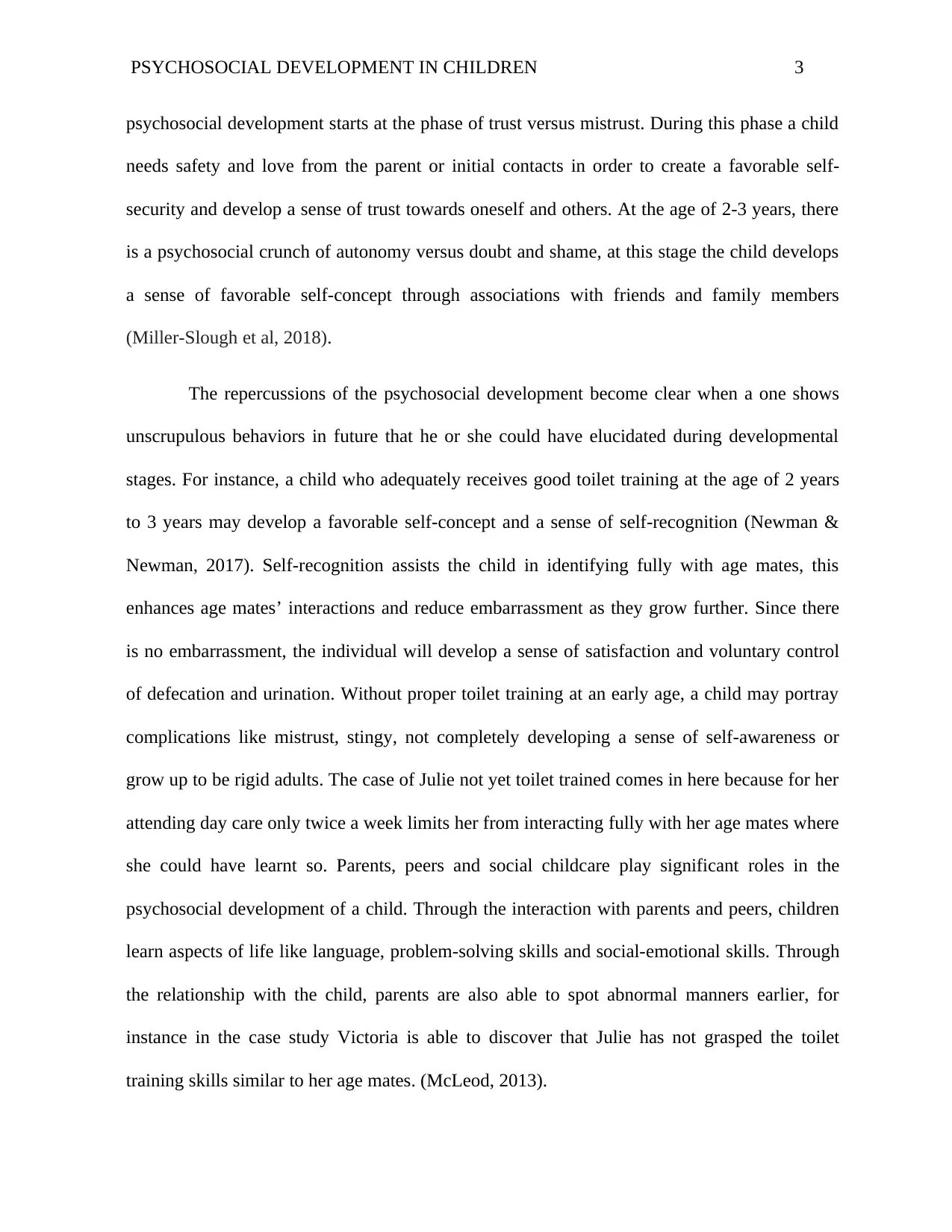
PSYCHOSOCIAL DEVELOPMENT IN CHILDREN 3
psychosocial development starts at the phase of trust versus mistrust. During this phase a child
needs safety and love from the parent or initial contacts in order to create a favorable self-
security and develop a sense of trust towards oneself and others. At the age of 2-3 years, there
is a psychosocial crunch of autonomy versus doubt and shame, at this stage the child develops
a sense of favorable self-concept through associations with friends and family members
(Miller‐Slough et al, 2018).
The repercussions of the psychosocial development become clear when a one shows
unscrupulous behaviors in future that he or she could have elucidated during developmental
stages. For instance, a child who adequately receives good toilet training at the age of 2 years
to 3 years may develop a favorable self-concept and a sense of self-recognition (Newman &
Newman, 2017). Self-recognition assists the child in identifying fully with age mates, this
enhances age mates’ interactions and reduce embarrassment as they grow further. Since there
is no embarrassment, the individual will develop a sense of satisfaction and voluntary control
of defecation and urination. Without proper toilet training at an early age, a child may portray
complications like mistrust, stingy, not completely developing a sense of self-awareness or
grow up to be rigid adults. The case of Julie not yet toilet trained comes in here because for her
attending day care only twice a week limits her from interacting fully with her age mates where
she could have learnt so. Parents, peers and social childcare play significant roles in the
psychosocial development of a child. Through the interaction with parents and peers, children
learn aspects of life like language, problem-solving skills and social-emotional skills. Through
the relationship with the child, parents are also able to spot abnormal manners earlier, for
instance in the case study Victoria is able to discover that Julie has not grasped the toilet
training skills similar to her age mates. (McLeod, 2013).
psychosocial development starts at the phase of trust versus mistrust. During this phase a child
needs safety and love from the parent or initial contacts in order to create a favorable self-
security and develop a sense of trust towards oneself and others. At the age of 2-3 years, there
is a psychosocial crunch of autonomy versus doubt and shame, at this stage the child develops
a sense of favorable self-concept through associations with friends and family members
(Miller‐Slough et al, 2018).
The repercussions of the psychosocial development become clear when a one shows
unscrupulous behaviors in future that he or she could have elucidated during developmental
stages. For instance, a child who adequately receives good toilet training at the age of 2 years
to 3 years may develop a favorable self-concept and a sense of self-recognition (Newman &
Newman, 2017). Self-recognition assists the child in identifying fully with age mates, this
enhances age mates’ interactions and reduce embarrassment as they grow further. Since there
is no embarrassment, the individual will develop a sense of satisfaction and voluntary control
of defecation and urination. Without proper toilet training at an early age, a child may portray
complications like mistrust, stingy, not completely developing a sense of self-awareness or
grow up to be rigid adults. The case of Julie not yet toilet trained comes in here because for her
attending day care only twice a week limits her from interacting fully with her age mates where
she could have learnt so. Parents, peers and social childcare play significant roles in the
psychosocial development of a child. Through the interaction with parents and peers, children
learn aspects of life like language, problem-solving skills and social-emotional skills. Through
the relationship with the child, parents are also able to spot abnormal manners earlier, for
instance in the case study Victoria is able to discover that Julie has not grasped the toilet
training skills similar to her age mates. (McLeod, 2013).
⊘ This is a preview!⊘
Do you want full access?
Subscribe today to unlock all pages.

Trusted by 1+ million students worldwide
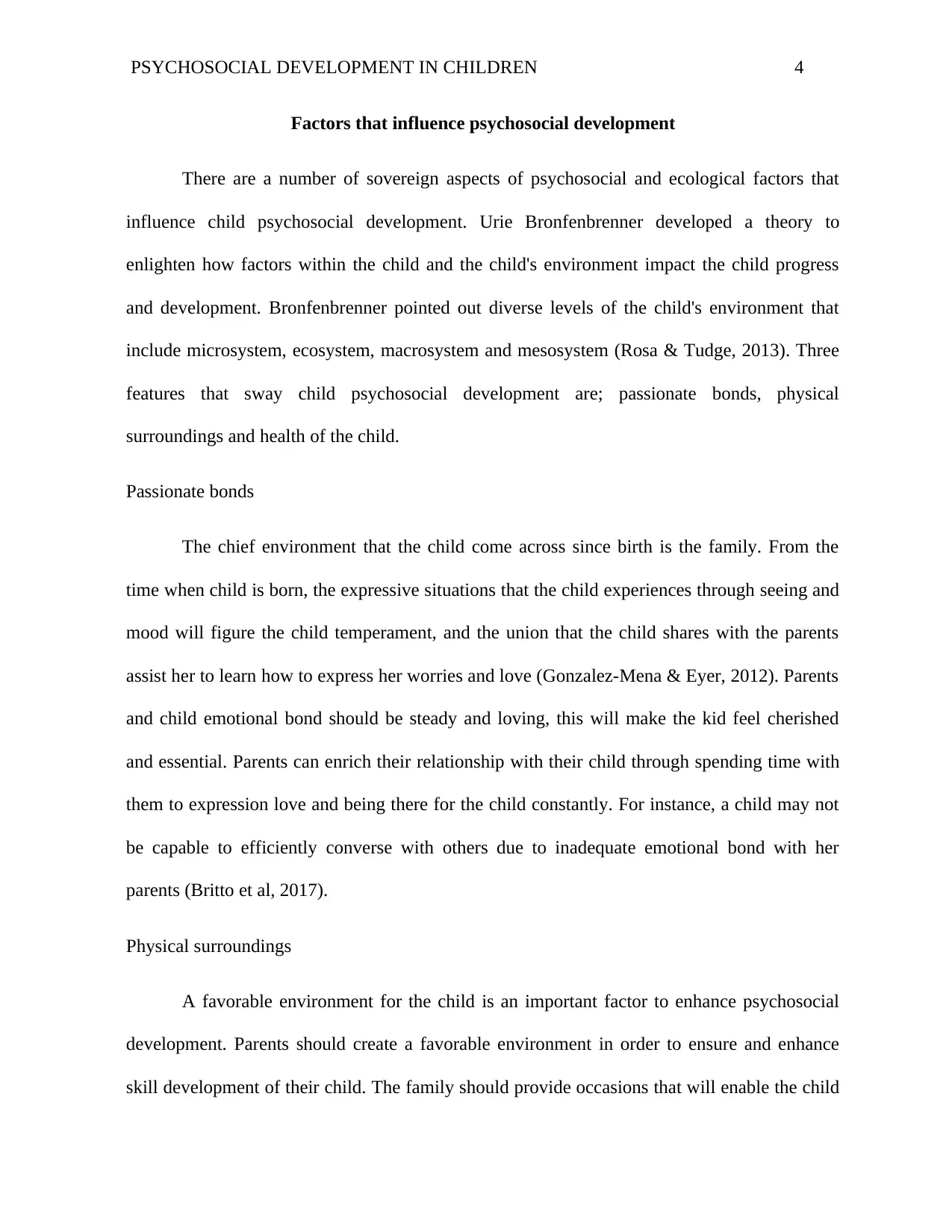
PSYCHOSOCIAL DEVELOPMENT IN CHILDREN 4
Factors that influence psychosocial development
There are a number of sovereign aspects of psychosocial and ecological factors that
influence child psychosocial development. Urie Bronfenbrenner developed a theory to
enlighten how factors within the child and the child's environment impact the child progress
and development. Bronfenbrenner pointed out diverse levels of the child's environment that
include microsystem, ecosystem, macrosystem and mesosystem (Rosa & Tudge, 2013). Three
features that sway child psychosocial development are; passionate bonds, physical
surroundings and health of the child.
Passionate bonds
The chief environment that the child come across since birth is the family. From the
time when child is born, the expressive situations that the child experiences through seeing and
mood will figure the child temperament, and the union that the child shares with the parents
assist her to learn how to express her worries and love (Gonzalez-Mena & Eyer, 2012). Parents
and child emotional bond should be steady and loving, this will make the kid feel cherished
and essential. Parents can enrich their relationship with their child through spending time with
them to expression love and being there for the child constantly. For instance, a child may not
be capable to efficiently converse with others due to inadequate emotional bond with her
parents (Britto et al, 2017).
Physical surroundings
A favorable environment for the child is an important factor to enhance psychosocial
development. Parents should create a favorable environment in order to ensure and enhance
skill development of their child. The family should provide occasions that will enable the child
Factors that influence psychosocial development
There are a number of sovereign aspects of psychosocial and ecological factors that
influence child psychosocial development. Urie Bronfenbrenner developed a theory to
enlighten how factors within the child and the child's environment impact the child progress
and development. Bronfenbrenner pointed out diverse levels of the child's environment that
include microsystem, ecosystem, macrosystem and mesosystem (Rosa & Tudge, 2013). Three
features that sway child psychosocial development are; passionate bonds, physical
surroundings and health of the child.
Passionate bonds
The chief environment that the child come across since birth is the family. From the
time when child is born, the expressive situations that the child experiences through seeing and
mood will figure the child temperament, and the union that the child shares with the parents
assist her to learn how to express her worries and love (Gonzalez-Mena & Eyer, 2012). Parents
and child emotional bond should be steady and loving, this will make the kid feel cherished
and essential. Parents can enrich their relationship with their child through spending time with
them to expression love and being there for the child constantly. For instance, a child may not
be capable to efficiently converse with others due to inadequate emotional bond with her
parents (Britto et al, 2017).
Physical surroundings
A favorable environment for the child is an important factor to enhance psychosocial
development. Parents should create a favorable environment in order to ensure and enhance
skill development of their child. The family should provide occasions that will enable the child
Paraphrase This Document
Need a fresh take? Get an instant paraphrase of this document with our AI Paraphraser

PSYCHOSOCIAL DEVELOPMENT IN CHILDREN 5
to discover even the environment within the home setting and outside the home. Comfortable
and encouraging home environment will assist the child to essence on her studies effectively.
Parents should try to avoid congested and boisterous environment because it can influence
child character negatively. According to Vygotsky's theory community plays a significant role
in social interaction, therefore, the community set up should be satisfactory to ensure that the
child absorbs the desired cultural values (Alparone & Pacilli, 2012).
The healthiness of the child
The dietary status which governs the health and welfare of a person is very crucial in
child’s development. Children who have unhealthy situations often do not depict the same
development cycle as others, they usually experience delayed psychosocial developmental
features. Unhealthy psychosocial conditions that are portrayed include delayed motor and lack
of sleep in children. Unhealthy conditions may be as a result of low level of cleanliness or lack
of accessibility to hospital. Features that can promote a clean environment, improved nutrition
and cure or prevent illness are of significance to ensure better psychosocial development
(Garbarino, J. (2017).
Significance of psychosocial development knowledge to my profession
Psychosocial development understanding is vital for all nursing students because it
provides discernment into finding strategies to advance child growth and progress. In the case
of a child who has difficulties in development, the nurse will deliver creative strategies to
recover the condition of the child in her care. The empathetic of psychosocial progress is
critical because it assists the nurse to deliver adequate developmentally care to the child with
psychosocial development difficulties (Batra, 2013).
to discover even the environment within the home setting and outside the home. Comfortable
and encouraging home environment will assist the child to essence on her studies effectively.
Parents should try to avoid congested and boisterous environment because it can influence
child character negatively. According to Vygotsky's theory community plays a significant role
in social interaction, therefore, the community set up should be satisfactory to ensure that the
child absorbs the desired cultural values (Alparone & Pacilli, 2012).
The healthiness of the child
The dietary status which governs the health and welfare of a person is very crucial in
child’s development. Children who have unhealthy situations often do not depict the same
development cycle as others, they usually experience delayed psychosocial developmental
features. Unhealthy psychosocial conditions that are portrayed include delayed motor and lack
of sleep in children. Unhealthy conditions may be as a result of low level of cleanliness or lack
of accessibility to hospital. Features that can promote a clean environment, improved nutrition
and cure or prevent illness are of significance to ensure better psychosocial development
(Garbarino, J. (2017).
Significance of psychosocial development knowledge to my profession
Psychosocial development understanding is vital for all nursing students because it
provides discernment into finding strategies to advance child growth and progress. In the case
of a child who has difficulties in development, the nurse will deliver creative strategies to
recover the condition of the child in her care. The empathetic of psychosocial progress is
critical because it assists the nurse to deliver adequate developmentally care to the child with
psychosocial development difficulties (Batra, 2013).
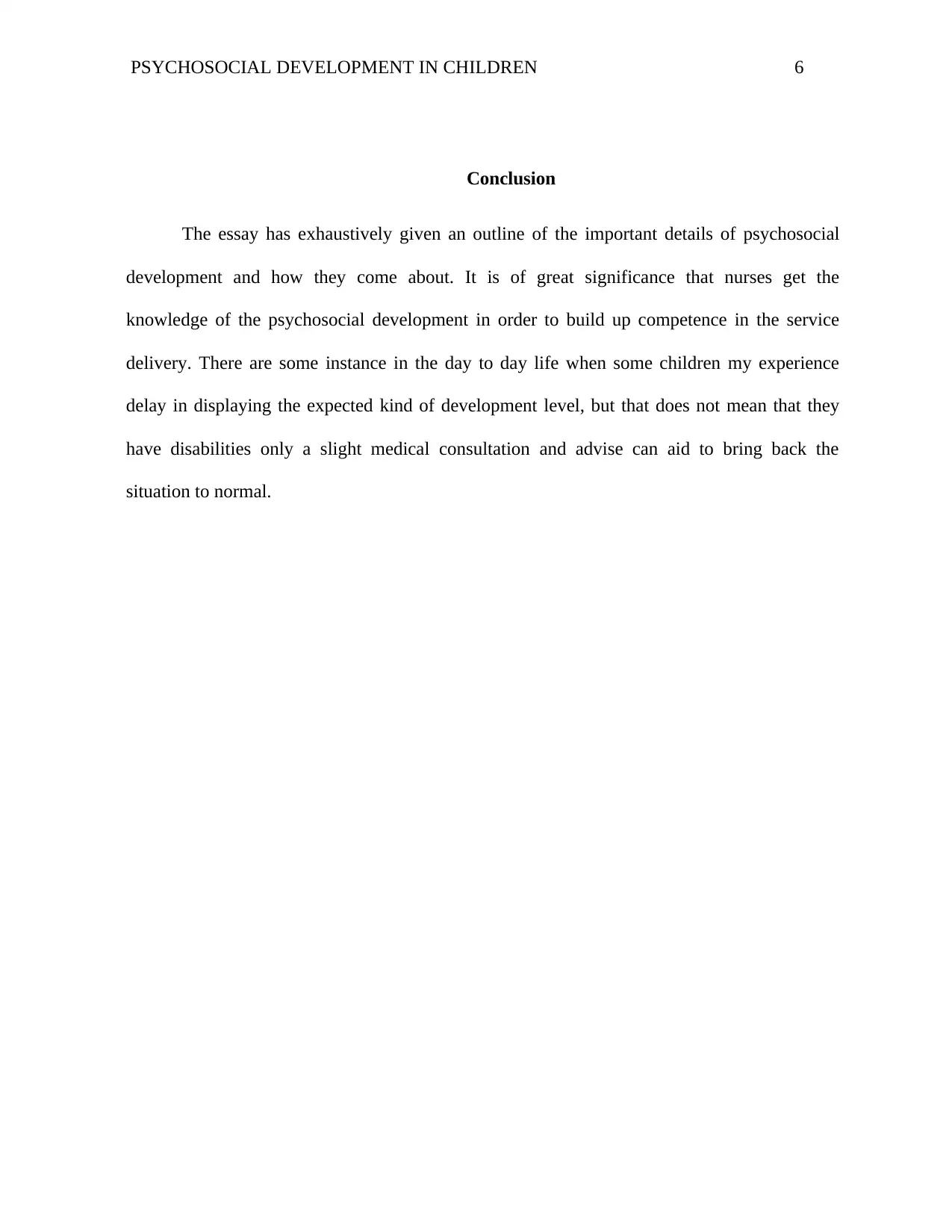
PSYCHOSOCIAL DEVELOPMENT IN CHILDREN 6
Conclusion
The essay has exhaustively given an outline of the important details of psychosocial
development and how they come about. It is of great significance that nurses get the
knowledge of the psychosocial development in order to build up competence in the service
delivery. There are some instance in the day to day life when some children my experience
delay in displaying the expected kind of development level, but that does not mean that they
have disabilities only a slight medical consultation and advise can aid to bring back the
situation to normal.
Conclusion
The essay has exhaustively given an outline of the important details of psychosocial
development and how they come about. It is of great significance that nurses get the
knowledge of the psychosocial development in order to build up competence in the service
delivery. There are some instance in the day to day life when some children my experience
delay in displaying the expected kind of development level, but that does not mean that they
have disabilities only a slight medical consultation and advise can aid to bring back the
situation to normal.
⊘ This is a preview!⊘
Do you want full access?
Subscribe today to unlock all pages.

Trusted by 1+ million students worldwide
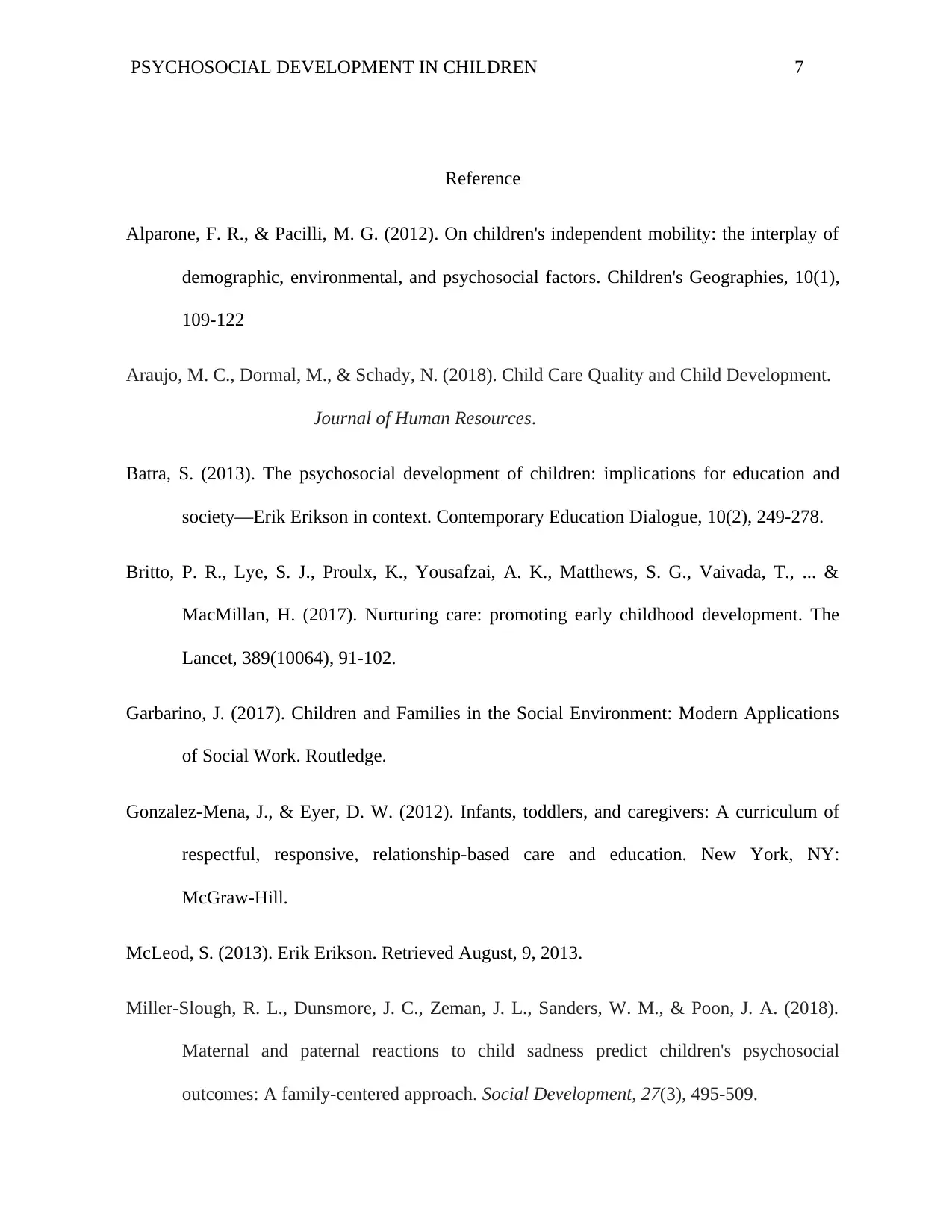
PSYCHOSOCIAL DEVELOPMENT IN CHILDREN 7
Reference
Alparone, F. R., & Pacilli, M. G. (2012). On children's independent mobility: the interplay of
demographic, environmental, and psychosocial factors. Children's Geographies, 10(1),
109-122
Araujo, M. C., Dormal, M., & Schady, N. (2018). Child Care Quality and Child Development.
Journal of Human Resources.
Batra, S. (2013). The psychosocial development of children: implications for education and
society—Erik Erikson in context. Contemporary Education Dialogue, 10(2), 249-278.
Britto, P. R., Lye, S. J., Proulx, K., Yousafzai, A. K., Matthews, S. G., Vaivada, T., ... &
MacMillan, H. (2017). Nurturing care: promoting early childhood development. The
Lancet, 389(10064), 91-102.
Garbarino, J. (2017). Children and Families in the Social Environment: Modern Applications
of Social Work. Routledge.
Gonzalez-Mena, J., & Eyer, D. W. (2012). Infants, toddlers, and caregivers: A curriculum of
respectful, responsive, relationship-based care and education. New York, NY:
McGraw-Hill.
McLeod, S. (2013). Erik Erikson. Retrieved August, 9, 2013.
Miller‐Slough, R. L., Dunsmore, J. C., Zeman, J. L., Sanders, W. M., & Poon, J. A. (2018).
Maternal and paternal reactions to child sadness predict children's psychosocial
outcomes: A family‐centered approach. Social Development, 27(3), 495-509.
Reference
Alparone, F. R., & Pacilli, M. G. (2012). On children's independent mobility: the interplay of
demographic, environmental, and psychosocial factors. Children's Geographies, 10(1),
109-122
Araujo, M. C., Dormal, M., & Schady, N. (2018). Child Care Quality and Child Development.
Journal of Human Resources.
Batra, S. (2013). The psychosocial development of children: implications for education and
society—Erik Erikson in context. Contemporary Education Dialogue, 10(2), 249-278.
Britto, P. R., Lye, S. J., Proulx, K., Yousafzai, A. K., Matthews, S. G., Vaivada, T., ... &
MacMillan, H. (2017). Nurturing care: promoting early childhood development. The
Lancet, 389(10064), 91-102.
Garbarino, J. (2017). Children and Families in the Social Environment: Modern Applications
of Social Work. Routledge.
Gonzalez-Mena, J., & Eyer, D. W. (2012). Infants, toddlers, and caregivers: A curriculum of
respectful, responsive, relationship-based care and education. New York, NY:
McGraw-Hill.
McLeod, S. (2013). Erik Erikson. Retrieved August, 9, 2013.
Miller‐Slough, R. L., Dunsmore, J. C., Zeman, J. L., Sanders, W. M., & Poon, J. A. (2018).
Maternal and paternal reactions to child sadness predict children's psychosocial
outcomes: A family‐centered approach. Social Development, 27(3), 495-509.
Paraphrase This Document
Need a fresh take? Get an instant paraphrase of this document with our AI Paraphraser
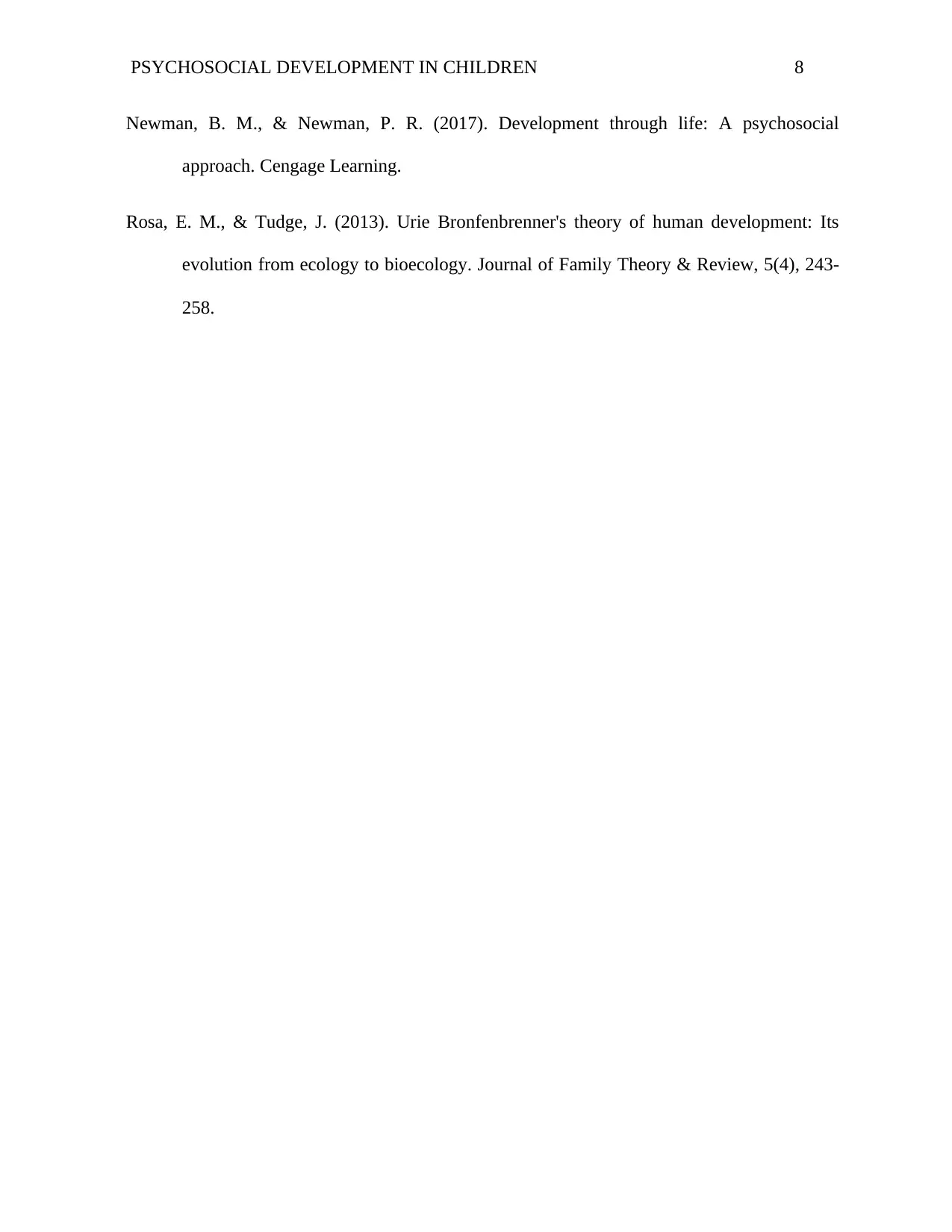
PSYCHOSOCIAL DEVELOPMENT IN CHILDREN 8
Newman, B. M., & Newman, P. R. (2017). Development through life: A psychosocial
approach. Cengage Learning.
Rosa, E. M., & Tudge, J. (2013). Urie Bronfenbrenner's theory of human development: Its
evolution from ecology to bioecology. Journal of Family Theory & Review, 5(4), 243-
258.
Newman, B. M., & Newman, P. R. (2017). Development through life: A psychosocial
approach. Cengage Learning.
Rosa, E. M., & Tudge, J. (2013). Urie Bronfenbrenner's theory of human development: Its
evolution from ecology to bioecology. Journal of Family Theory & Review, 5(4), 243-
258.

PSYCHOSOCIAL DEVELOPMENT IN CHILDREN 9
⊘ This is a preview!⊘
Do you want full access?
Subscribe today to unlock all pages.

Trusted by 1+ million students worldwide

PSYCHOSOCIAL DEVELOPMENT IN CHILDREN 10
1 out of 10
Related Documents
Your All-in-One AI-Powered Toolkit for Academic Success.
+13062052269
info@desklib.com
Available 24*7 on WhatsApp / Email
![[object Object]](/_next/static/media/star-bottom.7253800d.svg)
Unlock your academic potential
© 2024 | Zucol Services PVT LTD | All rights reserved.





